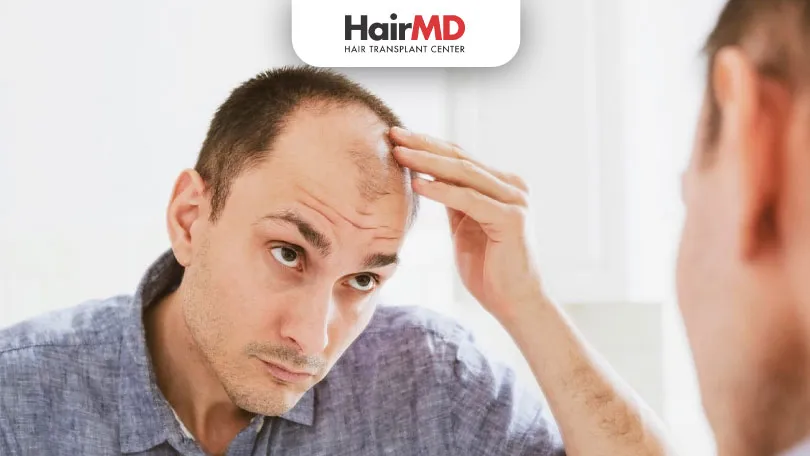27th May, 2025

Noticing a receding hairline or growing bald spot? You’re not alone. Hair loss affects millions of people—but if you’ve observed that it seems more common in men, you’re absolutely right. Hair Loss More Common in Men is a fact, as they are far more likely to experience significant hair loss, especially earlier in life. But why is that?
At HairMD, our expert hair specialist doctors in Pune explain the real science behind male hair loss and how it differs from female hair thinning. Understanding the root cause is the first step toward treatment—and prevention.
What’s covered in the article?
- The Biological Difference Between Male and Female Hair Loss
- Androgenetic Alopecia – The Most Common Type of Hair Loss in Men
- Why DHT Affects Men More Severely
- Hair Loss in Women – A Different Pattern
- When Does Male Hair Loss Start?
- Can Male Hair Loss Be Prevented or Reversed?
- FAQs
- Conclusion
The Biological Difference Between Male and Female Hair Loss
While both genders can lose hair, the causes and patterns differ dramatically.
In men, hair loss is primarily triggered by a hormone called DHT (dihydrotestosterone). DHT is a byproduct of testosterone and binds to hair follicles—particularly those on the crown and temples—causing them to shrink, weaken, and eventually stop producing hair.
Women produce much less testosterone and DHT, which means their hair follicles are less sensitive to this hormone. When women do lose hair, it’s typically more diffuse and rarely leads to complete baldness.
Quick Facts:
- Up to 30-50% of men experience noticeable hair loss by age 50.
- Only 40% of women experience visible hair thinning.
Androgenetic Alopecia – The Most Common Type of Hair Loss in Men
Androgenetic alopecia (commonly called male pattern baldness) is the most prevalent cause of hair loss in men. It is hereditary, meaning if your father or grandfather lost their hair early, you’re more likely to as well.
The classic signs:
- Receding hairline (especially at the temples)
- Thinning crown
- Horseshoe-shaped pattern of hair remaining around the back and sides
The process can start as early as the late teens or early 20s.
Why DHT Affects Men More Severely
Men’s hair follicles—particularly those in the frontal and crown areas—have a high number of androgen receptors. When DHT attaches to these receptors, it shortens the growth phase of the hair cycle and causes follicular miniaturization (shrinking follicles).
Women’s follicles are not only less sensitive to DHT, but they also have higher levels of estrogen, which protects against its damaging effects.
Stress, Lifestyle, and Environmental Factors
While hormones and genetics are primary causes, lifestyle factors also influence hair health.
Common triggers for both men and women:
- Stress and cortisol elevation
- Poor diet and nutrient deficiencies (zinc, biotin, iron)
- Lack of sleep and irregular routines
- Smoking and pollution exposure
However, men often ignore early signs and delay treatment—allowing the condition to worsen.
Hair Loss in Women – A Different Pattern
Women rarely go bald the way men do. Their hair loss usually manifests as:
- Overall thinning across the scalp
- Widening part line
- Hair fragility, especially during menopause or after pregnancy
In women, hormonal fluctuations (like those caused by polycystic ovary syndrome or menopause) are more commonly linked to shedding.
When Does Male Hair Loss Start?
Male-pattern baldness can start as early as age 18 and usually becomes noticeable by the mid-20s to early 30s. Without treatment, the condition typically progresses year by year.
Women generally experience thinning later in life—often after 40 or during menopause—when protective estrogen levels drop.
Can Male Hair Loss Be Prevented or Reversed?
Yes, especially if caught early. At HairMD India, we offer personalized treatments to slow or reverse hair loss, depending on the stage.
Effective Options Include:
- Finasteride (oral DHT blocker)
- Minoxidil (topical hair growth stimulant)
- Platelet-Rich Plasma (PRP) therapy
- Low-Level Laser Therapy (LLLT)
- Hair transplants for advanced loss
Psychological Impact – Why Early Treatment Matters
Hair loss affects more than appearance. Many men report a decline in self-confidence, increased stress, and even social anxiety.
Women tend to seek help earlier due to the emotional and social impact of thinning hair. Men, on the other hand, often wait until the condition becomes severe—limiting treatment success.
Frequently Asked Questions
Q. Is all male hair loss genetic?
A. Most cases are hereditary, but poor lifestyle, medical conditions, and medications can also contribute.
Q. Can women go completely bald?
A. Rarely. Women typically experience diffuse thinning, not full baldness.
Q. Is shaving the head helpful?
A. No. Shaving does not affect follicular health or regrowth potential.
Q. Can female-pattern hair loss be treated the same way?
A. Women require different treatment protocols, often with lower hormone modulation and more emphasis on nutritional support.
Do You Know?
Nearly 250 Patients Visit HairMD
Everyday For Various Hair Concerns?
(Your journey to healthier and fuller hair starts here!)
Meet Our Dermatologists
Conclusion
Male hair loss is more common than female hair loss primarily due to hormonal differences and genetic sensitivity to DHT. But just because it’s common doesn’t mean it’s untreatable. With early diagnosis and the right interventions, hair loss can often be slowed—or even reversed.
At HairMD India, a leading hair specialist in Pune, we specialize in scientifically backed treatments tailored to your individual needs. Book a consultation today and take your first step toward regaining control over your hair—and your confidence.
Further Reading
PRP Therapy for Hair Loss in Pune 2026 – Cost, Effectiveness & Results
Complete guide to PRP therapy for hair loss in Pune 2026. Learn about costs (₹3,000-15,000/session), 70-80% success rates, procedure details, and how it compares to FUE and medications.
Ethical Hair Transplant Practices – Why HairMD Pune Is Trusted?
Discover what ethical hair transplant practices look like and why patients trust HairMD Pune. Learn to spot red flags, verify surgeon credentials, and make informed decisions for your hair restoration journey
Low-Cost Hair Transplant Clinics in Pune – Risks & Warnings
Discover why ultra-low-cost hair transplants in Pune are dangerous. Learn red flags, true costs, and how to verify surgeon credentials before risking your scalp health.
Top Hair Growth Treatments for Women: Your Ultimate Guide
Find effective hair regrowth treatments for women. Explore solutions like PRP, medications, and more to combat hair loss with expert advice from HairMD.










